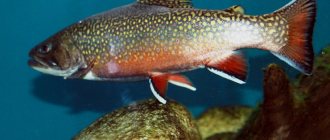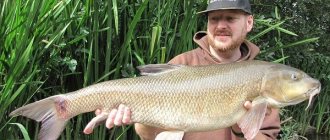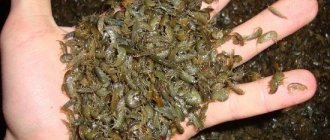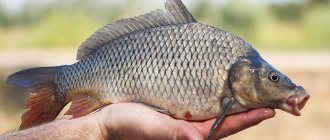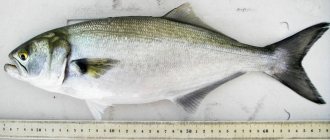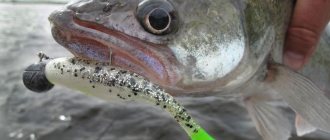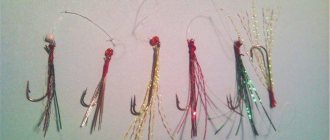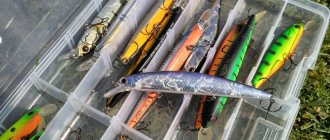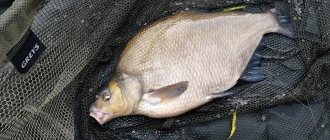What is navaga fish?
Content
These are small specimens of representatives of the Treskov order. They can weigh up to 700 grams. The fish is found in the northern part of Russia. It is somewhat reminiscent of cod, but its size is smaller and its body is more proportional. The color is camouflage with greenish olive tones, they can vary depending on the habitat. On the lower jaw of this fish there are short antennae equal to the diameter of its pupil. In the Sea of Okhotsk, this species of cod makes up the main part of the winter fishery.
Experienced fishermen know that starting in March, smelt go deeper and it is not possible to catch them. Therefore, the season begins from mid-autumn until the end of winter, when spinners for catching navaga will meet all expectations and delight you with a large catch.
From mid-autumn to the end of winter, the navaga fishing season begins.
It is worth preparing all the necessary material in early autumn, checking the fishing rod, line, and sinker. Spoons for smelt and navaga should be present in several varieties so that fishing is especially effective and the fish become interested in the bait.
The bait is selected several days in advance; worms, mussel meat, fish, pieces of lettuce, and also artificial baits are often used.
What kind of spoons are used for catching navaga, bait?
In practice, fish from the cod family are caught using bait or spoons. Fish bite on the latter less often and only in large sizes. In the fishing process, we use the vertical trolling method, in which the gear used in fishing includes a rod with an installed reel. There should be a fishing line in it with a reserve of at least 50 meters, a spinner is attached to it. The thickness of the fishing line used affects the quality of the catch; the thinner the fishing line, the better the spinner plays, the more attractive it is.
Common lures include:
- The nymph spinner for navaga is quite effective, made of metal and has a color from yellow-green to red-pink, made in the shape of a banana with a hook. This is a universal bait, which with its shape and size attracts various fishing objects and has a large number of positive reviews;
- The tipper spinner is made of several non-ferrous metals; it is possible to catch smelt and bison with it. The product bends poorly and, being unpretentious in handling, becomes dull over time, which can be easily corrected by using a special polishing paste;
- a spinner made of Leningrad silver is effective in fishing at great depths;
- jigs, bullets, knockers. Made in the shape of a bullet with a hollow inside, which creates a specific sound and attracts the attention of the fishing object;
Read more
How to catch bream with lard?
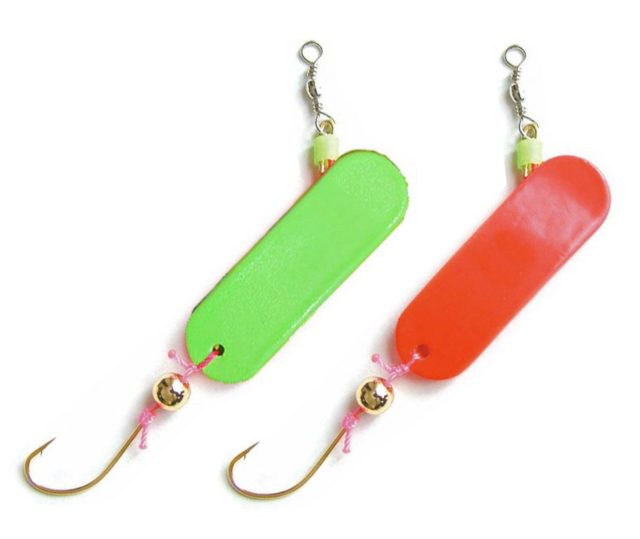
Fish of the cod family are caught using a spoon
- the needle spinner for navaga is made of white stainless steel with a red and copper ball, which is sure to attract attention;
- The tungsten spinner is small in size and heavily weighted, which allows it to play well on the water and quickly fall to the bottom. Applicable at great depths, with strong currents, you can easily fish during severe frost and wind.
Experienced fishermen prefer to make spinners with their own hands; there can be more than 20 options for such blanks. The most effective ones for fishing in winter are selected from them.
However, it is not only the spoon that improves the quality of fishing, but also the technique. The smelt is a modest fish, often fished for smooth movements without jerking. The bait sinks to the bottom, after which it waits a few seconds and very carefully makes 3-4 jerks with a delay of a couple of seconds. If the fish bites sluggishly, then you should experiment with spoons and bait.
Seasonal fishing
This representative of cod, like other fish, is distinguished by its biting activity throughout the year. Despite the numerous flocks, it is not easy to find navaga in the sea, since in the summer it stays at a considerable depth, and with the onset of winter it approaches the coastal zone.

Navazhya fishing in summer
Sea fishing in open water involves the use of a boat. In the warm season, schools gain weight at depths of 30 meters, so casting from the shore is out of the question. Short rods are used because it is easier to use vertical lures this way. Retrieving is carried out at the bottom, with small twitches and pauses between them. For sea fishing, a multiplier reel is used; it is more adapted to specific fishing conditions. When assembling tackle, it is necessary to take into account the greater depth and the use of large sinkers. The test rod must have a reserve so that the fisherman can cope with all the difficulties of the sea.
In addition to spinners, locals use bottom gear. The bait is prepared in advance in the form of sea worms, sliced fish, meat, and lard. Navaga is not large, but its bite is capable of knocking the rod out of the hands of a careless fisherman. Their peculiar disposition forces individuals to compete and greedily grab the bait in a race. If the flock is found, the success of the event is guaranteed.
In order not to miss the location of the prey, it is necessary to use an echo sounder, which will not only give indications of the presence of fish, but will inform about changes in the nature of the bottom.
Fishing for navaga in autumn and winter
As the water temperature drops, the flocks gradually move to the coastal zone of the seas and even enter small rivers. The fish does not migrate far; it can be found a maximum of 15 km from the mouth. Before the ice freezes, navaga is successfully caught from the shore with donks and float rigs. The most successful time is considered to be high tide, then the fish are caught with a fly rod and a Bolognese rod. For donkey, a spinning rod with a height of 3 m and a weight of up to 100-120 g is suitable. Fishermen use specialized “sticks” for sea fishing, although an ordinary feeder is also suitable.
To learn more:
Advantages of a Kevlar leash for pike
In winter, the bite becomes more active at river mouths, where fishermen wait for navaga. In ice fishing, spoons with a soldered hook are used. The saffron cod bites worse on stationary fishing rods with attachments, since the species is still a predator. The peak of activity is observed during the first ice period and within two weeks after the formation of the ice surface. Then the bite subsides and resumes only on the last ice.
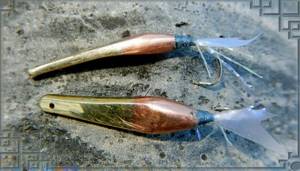
Material and hooks for spinners for navaga
To catch navaga, a convenient fishing rod is used, which can be factory-made or homemade; among them, preference is given to a combine harvester. The handle is made of foam or wood, a special whip is inserted into it, its length is up to 25 cm. At the end of such a whip there is a fishing line clamp, it is made of rubber. The handle of the device serves as a kind of skein; a fishing line of up to 30 meters is wound onto it. A fishing line with a diameter of 0.4 to 0.6 is used, depending on the size of the fish. This fishing rod consists of two lines, which increases the chances several times.
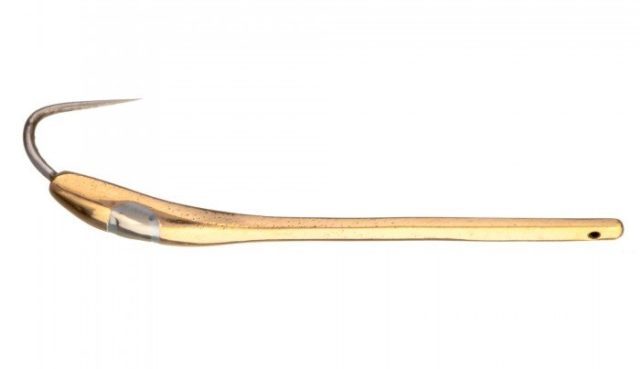
A special knotting technique is used to avoid hook loss and catch jumping off.
When fixing the hook, fishing knots are used; there are a large number of them:
- Crawford knot;
- fishing eight;
- Canadian eight;
- step unit.
To avoid losing the hook and the catch jumping off, a special technique of tying knots is used; experienced fishermen are familiar with them.
The spoon is made of various metals: copper, brass, stainless steel. The hook is suitable for a factory-made product of size 5-7; they are used when fishing involves putting on bait. Can be made from steel wire.
Bait can be very diverse from vegetables to meat and fish; mussels are often used; they are found on sticks in small reservoirs during summer fishing.
Read more
What to feed carp with?
Question about gear for winter fishing for smelt and navaga
Please tell me if they are used when fishing for smelt, navaga, etc.
In the Primorsky Territory, when fishing for smelt, catfish and navaga in winter, they have long used lightweight spinners that are not burdened by the presence of lead. A lightweight spinner with an elongated teardrop shape, due to its peculiar curved shape at the moment of free fall, its play most closely resembles the natural movement of a small fish. These spoons are made of brass, copper, cupronickel, etc. Spoons made using this method are also good because the size of the spoon has little effect on the size of the fish that takes it. Very often, a lure 100 mm long can be used to catch fish much smaller in size than the lure itself. At the same time, large fish take the lure at 20-30 mm.
Of course, such a lure also requires special fishing rod equipment. The main difference from conventional equipment is the shape and location of the sinker. The sinker is cast in the shape of a spindle with a piece of wire 1 mm thick passed inside it. After casting the sinker, the wire is cut so that 2 cm remains at both ends of the sinker. Then two 2 cm pieces of cambric are selected, equal in thickness to the wire mounted in the sinker.
I don’t specifically focus on the size and therefore the weight of the sinker, because... these parameters depend on the fishing depth, the presence and strength of the current. Therefore, fishermen, as a rule, carry with them, along with a set of spinners of different sizes (from 20 mm to 100 mm) and a set of sinkers of different weights.
Coastal fishermen use fishing rods made of dense foam plastic with a reel; a strip of bamboo or fiberglass is suitable as a fishing rod. A rubber ring from an old hose of the appropriate diameter is placed on the tip of the fishing rod to secure the fishing line. 15 meters of fishing line 0.3 or thicker are wound on the reel, because a thick fishing line gets tangled less, and if you still can’t avoid a beard, it’s much easier to untangle it. Pass the free end of the fishing line through the rubber ring and put the prepared cambrics on it (for attaching the sinker). A loop is made at the end of the fishing line. The selected sinker is inserted into the cambrics. The spoon is attached to the main line using a leash. The leash is made 50-70 cm long from a fishing line with a diameter of 0.17 cm or the diameter that suits you when catching a particular fish. A loop is also made at the end of the leash. The leader with the lure is attached to the main line using the “loop-to-loop” method, which allows you to quickly and easily change the leader with another lure.
Such equipment for a winter fishing rod also requires a special way to set the fishing depth. Since the spoon itself is much lighter than the sinker, determining the moment it touches the ground is not an easy task. There are two options to solve this. You notice how many revolutions the leash takes on the reel and, after the sinker has touched the bottom, you rewind the number of revolutions of the leash you noticed back onto the reel. For the second option, it is necessary to make a “diver”.
“Diver” is an ordinary sinker weighing 30-50 grams covered with fabric. So, you put the “diver” on the spoon and first remove the rubber ring from the tip of the fishing rod, which presses the main fishing line to it. Lower the tip of the rod to the hole and unwind the line from the reel until the “diver” touches the bottom. Having fixed the main line on the fishing rod with a rubber ring, you select the tackle and remove the “diver”. Thus, the distance of the tip of the fishing rod from the hole will be equal to the distance of your spoon from the bottom, and you can easily and “visually” fish any layer of the water column, moving away from the hole or, on the contrary, sitting down to it.
The fishing technique itself is quite simple. A small short swing of the fishing rod and your spoon is torn off the ground and soars into the water column. A short pause, allowing the spoon to glide back to the bottom and swing and hook again.
The game of the spinners is tested at home in the bathroom. A correctly made spoon, after lifting, progressively floats “on its back” to the side. The fish always grabs the spoon as it falls. In order not to unnecessarily freeze their hands when removing gloves, our fishermen use hooks on spinners without barbs, and to prevent the fish from coming off after hooking, it is reeled in with quick swings that do not weaken the line, wrapping the line around the hands. After removing the fish, it is thrown onto the ice and the spoon unhooks itself. All that remains is to lower the sinker into the hole and release the wound line from your hands.
Very advanced spinners can fish with EIGHT different spinners at the same time (four on each rod) and accurately reel in the line that caught the fish.
Also, to catch smelt from the ice, fishermen use flywheels, tying small spoons on a thin line:

How to make a spinner for navaga with your own hands?
You can not only buy state-issued material for fishing, but you can also make it yourself using improvised means; the quality of fishing will not suffer from this, but will only benefit.
So making a spinner for navaga with your own hands is done from materials such as:
- beer caps;
- wire;
- lead balls;
- winding ring.
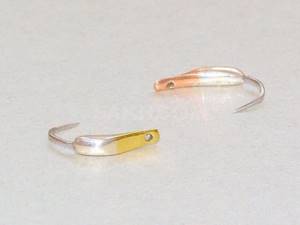
The production of a spinner for navaga goes through the following stages, which include:
- take a piece of wire, it repeats the size of the existing spoon;
- the lower area of the wire is rounded;
- use used bait by unfastening the sinker;
- two plugs are pressed together in such a way that it is possible to place lead balls inside;
- a shell made of lids is fixed on a wire, and winding rings are attached to the top and bottom;
- We tie a hook at the bottom;
- After this, the product is attached to the fishing line.
The hook is selected in proportion to the spinner, you can make it yourself using strong stainless steel wire, it is bent (shaped into a hook shape), and then the tip is sharpened. It is located at the end and is quite thin so that the fish does not feel the moment of penetration at the initial stage.
And so the gear for catching navaga at the final stage should include:
- fishing rod;
- bait;
- several types of spinners;
- fishing line;
- automatic or manual reel;
- factory or homemade hooks;
- bait.
In winter, a drill is added to the components, which drills holes; during this period, the fish prefers to be close to the shore, and there the crust is much thicker.
Usually, raw meat, small pieces of fish, lard and worms, as well as slices of mussels are used to catch navaga in the summer. Bait made from jacket potatoes and krill has proven to work well; the ingredients are kneaded and placed in a fabric bag, after which it sinks to the bottom. The smell will attract the objects of fishing for a short period of time.
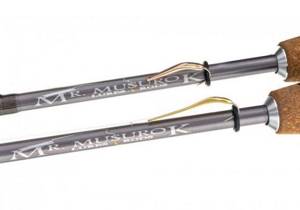
A convenient fishing rod is used to catch navaga
Bait for navaga
Of course, fish can be caught without bait, but there are times when there is fish, and you know it for sure, but it simply doesn’t bite or has dispersed throughout the reservoir and wanders there alone in search of something tasty. or, for example, when the reservoir is new and we don’t know where to start fishing.
In such cases, bait is like a lifesaver. Pour it into the hole, and wait for the fish to gather for a tasty smell.
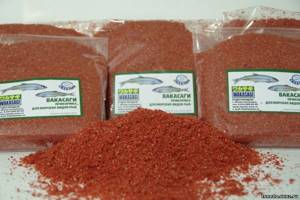
The “WAKASAGI” bait is designed for up to 5 meters and is most popular among fishermen.
But not everything is as simple as it seems at first glance. Feeding has its own subtleties and tricks. For example, winter feeding is different from summer feeding.
In winter, in icy water, all vital processes in fish are inhibited. But there are components that help stir up sleepy fish. One of them is ordinary salt, and this has already been proven. Salt activates the digestive process, increasing the fish's appetite.
In Japan, most winter baits contain salt. The amount of salt added to bait is always different - it depends on the salinity of the reservoir, the temperature of the water, and the fish for which the bait is designed.
In winter, the amount of bait should not be as large as in summer. After all, now the fish moves much less and more slowly than in the summer, and it does not require much energy, and therefore not much food. And given the weak appetite of the fish, winter complementary foods should contain only high-quality products in order to surely seduce the capricious fish.
Anglers often argue about what and how to feed. on the one hand, the “correct” bait is pure krill and the “bad” bait is various dry mixtures of plant products with additives. The dispute does not stand on its own, because there are common cases when on holes massively fed with krill, a lot of not only smelt are caught, but also flounder, rudd, and even kunja.
Many fishermen use Japanese krill. Unfortunately, it is not always effective, which is why Japanese krill is harvested in the Pacific Ocean in southern Japan, at the border of cold and warm currents. The size of krill is up to ten millimeters, in contrast to ours, which is only 2-3 mm, and therefore large Japanese krill is not the usual food supply for smallmouth smelt.
So, Sakhalin krill is the most affordable and popular type of food used by fishermen for fishing. And the biggest mistake of all fishermen, in pursuit of a big catch, fishermen often pour out kilograms of this very krill.
On the one hand, this is good, the fish comes up quickly, but just as quickly it gets full, and the appetite disappears for several hours. This explains the wave-like tides of bites. Krill is a food source
base for fish.
Yes, there are inexplicable periods when fish don’t bite at all, and after a moment, as if on some signal, they can greedily start pecking.
But in the case of krill, the fish comes to a dinner party, eats up and naturally becomes indifferent to all the types of bait that the fishermen have stocked up on.
In these cases, dry bait gives a wonderful effect. She not only collects fish, but also does not allow her to get enough, and the constant smell of delicious food does not allow her to move far from the feeding place.
Based on our many years of observations, we slightly adjusted the Japanese bait recipe and adapted it to Sakhalin fish
Sakhalin baits “WAKASAGI”, “Catching Smelt”, “Plum Boom”, “NAVAGA”
and bait for those who fish with
FLAMINGO
. Each bait has its own degree of humidity in order to fish at recommended depths.
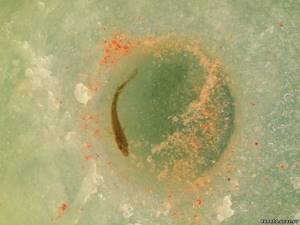
With Flamingo bait you can fish without lowering the hooks.
Having lowered the underwater video camera, we observed how the fish reacted to different types of bait.
The correct bait should disintegrate into a small fraction, dissolve in the water when falling, forming a trail of smaller particles and, having fallen to the bottom, begin to “play”, i.e. the particles of the bait should gradually rise and then fall to the bottom again.
Such a game of bait arouses great interest among fish, even turning into some kind of excitement.
Bait for Sakhalin reservoirs includes the whole set of “goodies” - here is krill, and grains, and components that are not produced in Russia; they have to be bought in Japan. For example, on Lake Izmenchivoe, it is enough to take about three hundred grams of bait per hole. If you add a tablespoon of the mixture to the hole and feed it wisely, then this amount of food is enough for 5-7 hours of fishing.
The effectiveness of mixed (animal plus plant) feeding when catching smallmouth, bison and navaga can be clearly confirmed by the fact that very often the fish responds well to the various “sandwiches” that we make on the hook. For example, navaga sometimes doesn’t want to take on a sea worm, even the most selected one, but you put a steamed pea on the swab and it immediately bites. So, by observing how the fish treats the bait, it is largely possible to predict many aspects of feeding.
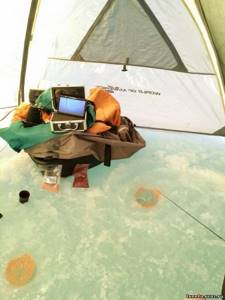
The smallmouth usually approaches complementary feeding quickly. About fifteen minutes pass after feeding, and you can start fishing. It is better if you feed several holes nearby at once. Then the area increases and the fish gather in large quantities. The diameter of the circle is about 5-7 meters.
In the evening you need to feed less, because complementary feeding may not activate, but sharply reduce the intensity of bites (this is from practice). Therefore, at the end of fishing, do not pour the remains of the bait into the hole in the hope of catching more, but take it with you - it will do for next time.
High-quality winter bait is far from a simple thing and needs to be saved.
Another erroneous judgment of “experienced” fishermen. Bait on the current. Why feed your neighbor, all the complementary food will go downstream. Of course, you can fish with a stationary feeder, lowering it to the bottom in an adjacent hole upstream. But I use this feeder very rarely, and more often I use another method.
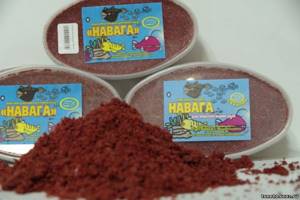
The NAVAGA bait is designed for up to 7 meters, but can be used in a tampon.
I moisten the dry mixture, form a ball (or several balls) and release it with a standard feeder to the very bottom. It would seem that everything is simple, but the ball will fall to the bottom only if it is properly moistened.
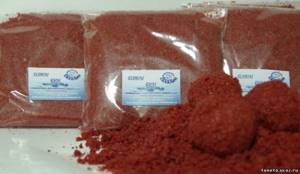
The PlumBum bait is designed for depths of up to 15 meters.
In the cold, it is more difficult to moisten complementary foods sufficiently, because water is poorly absorbed into the mixture. It would seem that the mixture is sufficiently moistened, but when stirred it becomes semi-dry again, so you have to moisten it additionally.
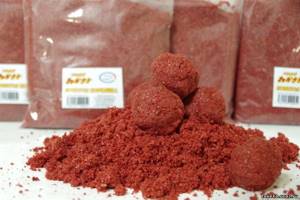
The bait “Catching smelt” is designed for up to 10 meters. It is necessary to form a ball tightly.
The bait ball should sink quickly, lie on the bottom under the hole, and not be carried by the current
What is the most important thing in bait? Probably everything is very important in the complex! The time of disintegration of the ball in water, the degree and method of moistening the mixture, its activity (the intensity of the separation of floating particles), nutritional value (nutritional value), particle size, its weight and smell. And of course, color is a very important point, which often affects the result of fishing, because bait of a specific color attracts or, on the contrary, repels fish of a certain type and size in certain conditions.
It is better to use a bait color that resembles the color of the food base, for example krill, shrimp, plankton. The bait in this case is red. Closer to spring, blue or green bait sometimes works well.
Good mood, good weather and great catches to everyone.
Time and place of fishing
Fishing is carried out in all reservoirs in which this type of cod is found in the seas:
- Yellow;
- Japanese;
- Chukotka;
- Okhotsk;
- Bel.
And also the ocean:
- Ledovit;
- Quiet.
The Sea of Okhotsk is the richest in the presence of representatives of navaga; it belongs to the main type of fishing in winter.
Read more
Millet bait for fishing
In winter, fishermen make several holes from 2 to 5, the best option, and use twitching to catch fish. In summer the catch is much more modest.
This predator loves cold water; when it gets warmer, the fish sinks to the bottom and leads a sedentary lifestyle, preparing for winter and gaining fat deposits. Spawning occurs in places of sea tributaries.
Techniques and tactics for catching flounder
- It is recommended to cast the tackle further away, positioning the rod at a large angle. Some piers have special sides that are just right for a convenient position of the fishing rod.
- Flounder behaves especially when biting; it can grab prey and lie motionless for some time. If there was a long cast, then such a bite can be missed.
- It is important to carefully monitor the condition of the rod; a shudder will appear at the tip when the fish moves.
- They hook flounder quickly and confidently. Catching such a fish does not tolerate slowness. It should be remembered that flounder can actively resist. That is why, before pulling her towards you, it is advisable to tire her out.
- Flounders tend to swallow bait deeply; in this case, you need to have an extractor or hook with you.
- You will have to make some components of the equipment yourself. These include leashes; there should be at least 10 of them in stock.
- Fishing on a boat eliminates the need to take heavy weights. This is due to the fact that the rod does not need to be cast far.
- The boat uses vertical fishing techniques, alternating tapping on the bottom and small casts along with pulling up the equipment.
- The more powerful the tackle, the easier it is to pull out the flounder while fishing.
